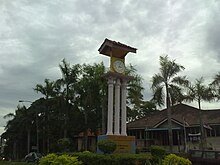
Negeri Sembilan, historically spelled as Negri Sembilan, is a state in Malaysia which lies on the western coast of Peninsular Malaysia. It borders Selangor on the north, Pahang in the east, and Malacca and Johor to the south.

Seri Menanti is a town, a mukim, and a state assembly constituency in Kuala Pilah District, central Negeri Sembilan, Malaysia, located 33 km east of the state capital city of Seremban and 14 km southwest of Kuala Pilah. It is the royal capital of the state of Negeri Sembilan and houses the seat of the ruler of the state of Negeri Sembilan, referred to as the Yang Di-Pertuan Besar of Negeri Sembilan or Yamtuan Besar. The royal palace is known as Istana Besar.

The Jelebu District is the second largest district in Negeri Sembilan, Malaysia after Jempol, with a population over 40,000. Jelebu borders on the Seremban District to its west and Kuala Pilah District to its south, Jempol District to its southeast, Bentong and Bera Districts, Pahang to its east and Hulu Langat District, Selangor to the north. Jelebu is a suburban district with blossoming semi-agricultural industry. Jelebu is also a parliamentary constituency of the Dewan Rakyat in the Malaysian Parliament. Kuala Klawang is the principal town of the district.

The Segamat District or simply Segamat is a district in the Malaysian state of Johor. Segamat is also the name of the district's primary town. Segamat district is one of the three landlocked districts in Johor, the other being Kluang and Kulai.

The Jempol District is the largest district in the Malaysian state of Negeri Sembilan. The district borders Jelebu District to the northwest, Kuala Pilah District to the west, Tampin District to the south, Bera District, Pahang to the northeast and Segamat District, Johor to the east. Bandar Seri Jempol and Bahau are the principal towns in Jempol.

The Muar River is a river which flows through the states of Negeri Sembilan and Johor in Malaysia. Its drainage basin encompasses the states aforementioned, as well as Pahang and Malacca.

The Kuala Pilah District is a district in central Negeri Sembilan, Malaysia. Its seat is the town of Kuala Pilah.
Mentakab is a town, a mukim (commune) and a state assembly constituency in Temerloh District in central Pahang, Malaysia. It is 9 km (5.6 mi) northwest from downtown Temerloh and 82 km (51 mi) northeast from Kuala Lumpur.

Batu Kikir is a small town in Jempol District, Negeri Sembilan, Malaysia. Situated along the Tampin-Karak highway, Batu Kikir is located in between Bahau and Kuala Pilah.

Rompin is a small town located in Jempol District, Negeri Sembilan, Malaysia, on the banks of the Muar River. Rompin developed as a town for the local community nearby. The village around Rompin town is Kampung Baru Rompin, Kampung Rompin, Kampung Balai Cina, and Kampung Tanah Panjis.
The Laluan Penarikan were a series of portage routes across the Malay Peninsula. The most famous of these routes connected the Muar River with the Pahang River. The Penarikan shortened the journey of water vessels sailing between the Strait of Malacca and the South China Sea.
Tan Sri Zainal Abidin bin Ahmad or better known by the moniker Za'aba, was a Malaysian writer and linguist. He modernised the Malay language with the publication of a series of grammar books entitled Pelita Bahasa in 1936 at the Sultan Idris Training College. The book contained guidelines in modernising the structure of classical Malay, transforming it into the language that is in use today: the most significant change was the switch from the conventional passive to the modern active form of syntax.

Era Baru Sdn Bhd is a Malaysian property development and investment holding company based in Seremban, Negeri Sembilan in Malaysia. The company was incorporated on 8 September 1981 under the umbrella of Grand Linage Sdn Bhd. Since its incorporation, Era Baru together with its parent company and other subsidiaries have successfully completed more than 4,000 units of residential and commercial properties within Negeri Sembilan, with total sales revenue of more than RM146 million.

The Seremban District is one of 7 districts in Negeri Sembilan, Malaysia. This is where the capital of Negeri Sembilan, Seremban is located.

The Bahau railway station is a Malaysian railway station located in and named after the town of Bahau, Jempol District, Negeri Sembilan. Located near Taman Kwang Hup, it is one of the major railway stations of KTM's East Coast Line meaning that available express trains will also stop at this station.

Seremban is a city in the Seremban District and the capital of the state of Negeri Sembilan in Peninsular Malaysia. The city's administration is run by the Seremban City Council. Seremban gained its city status on 20 January 2020.
Federal Route 246 is a federal road in Negeri Sembilan, Malaysia. The Kilometre Zero of the Federal Route 246 is at Batu Kikir. This road is an inland road that connects to Bahau from Batu Kikir. The more popular option is Route 13 near Juasseh.

Kuala Pilah, or simply Pilah, is a town in Kuala Pilah District, Negeri Sembilan, Malaysia. It is 36 km from the state capital Seremban and 101 km from Kuala Lumpur.

Pak Ka Choon Village is a small village located in Bahau, Negeri Sembilan state, Malaysia.























